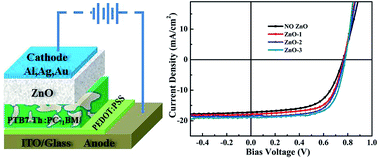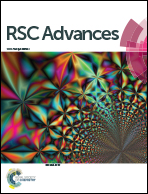Efficient polymer solar cells employing pure ZnO cathode interlayers without thickness-dependent and light-soaking effect and negligible electrode selection†
Abstract
Polymer solar cells (PSCs) have attracted tremendous attention as a promising candidate for potential clean and renewable energy technology. Dramatic progress in bulk heterojunction PSCs has been achieved with power conversion efficiency (PCE) exceeding 10%. As a promising cathode interfacial layer in practical device application, the solution-processable pure ZnO nanoparticles (NPs) always lead to surface charge recombination, and hence varied surface modification of the ZnO layer has been developed to enhance the device performance. Herein, we report single-junction PSCs with PCE as high as 10.04% in the conventional structure, employing pure ZnO as a cathode interlayer. It is found that the surface composition of ZnO NPs strongly affects the interfacial charge recombination and final photovoltaic performance of the resultant devices. The fabricated PSCs employing the optimized pure ZnO NPs feature both a thick active layer and a thick ZnO interlayer, and demonstrate a negligible light-soaking effect and cathode selection. This work provides efficient PSCs in which all layers can meet the requirements of various printing techniques in practical large-scale manufacture.


 Please wait while we load your content...
Please wait while we load your content...